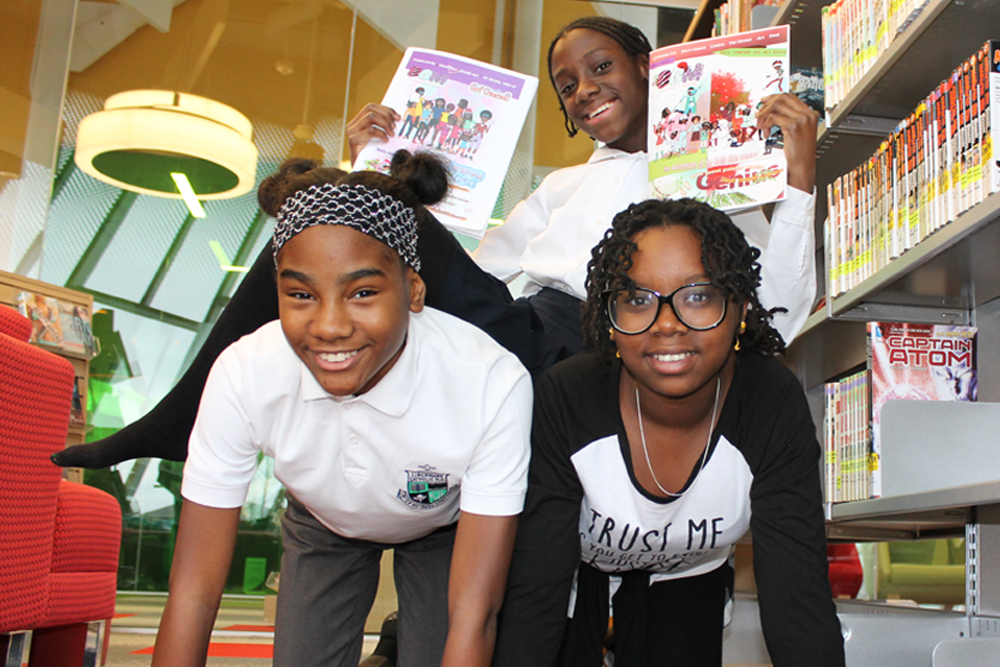
Black History Month spotlight:
Black Girls Magazine: OISE PhD student inspired to make a difference
Annette Bazira-Okafor changing the face of pop culture
By Lindsey Craig
February 21, 2017
When OISE PhD student Annette Bazira-Okafor saw the magazines and apps her daughter and her friends were using, she knew something was missing – representation of the girls themselves.
“They just aren’t there. The way they do their hair, their skin tone, it’s not represented,” she said.
“It sends a message that they’re not part of the norm. It’s not right,” she continued. “It’s important for them to have a voice.”
So, Bazira-Okafor decided to give them one.
One Friday evening, she got the girls together (“They’re always having sleepovers at my house, so I already had them there,” she laughed), and asked them to share their experiences in written stories, images, cartoons– whichever way they wanted to express themselves.
The result was far beyond what Bazira-Okafor had ever dreamed.
“I just thought, ‘Why would we keep this [for ourselves] and not have other people look at it?’” she said.
And so, with that, Black Girls Magazine was born.
Using her own resources, Bazira-Okafor had the first issue printed.
It wasn’t long before word began to spread among friends and families. Soon after, schools and libraries too, wanted the magazine on their shelves.
“People loved it. They really embraced it. And I think that was really important for the girls to see– that their work was important, that they were important. It validated them,” Bazira-Okafor said.

The contributors of Black Girls Magazine
Fighting stereotypes
Content in the magazine ranges from running for school council president, to “Weird questions people ask me about my hair”, to family trips abroad and a comic strip.
The girls say the chance to talk about their real-life experiences helps fight stereotypes of how black girls are often portrayed.
“At my school, there’s a lot of black people but then, the white people there, they always assume that black people, they, like, live in the hood, and they’re all very poor,” said Morgan, 13. “So I feel like if we show that we’re something greater than, like, a bum or something, then I feel that that will help us a lot in breaking the stereotype.”
In one issue, Taylor, 12, was inspired to write about her impressions of the Disney movie Queen of Katwe, a film about a Ugandan girl who becomes a top chess competitor.
“I love Black Girls Magazine because it represents us, and the things that we like to do,” Taylor said.
“We need to show other black girls in the world that they don’t have to keep quiet and they don’t have to conform to what the world thinks you should be,” said Mbabazi, 13, who creates caricatures of girls in the magazine.
OISE ‘gave me confidence’
As for what inspired her to create the magazine, Bazira-Okafor said her studies at OISE have been empowering.
“It’s amazing. I love the course work. It’s made me think about the world differently, and it gave me confidence to be able to boldly say what I want to say,” she said.
“I have amazing professors. They really guide me,” she continued, specifically noting the influence of Professors Njoki Wane, George Dei, and Miglena Todorova.
“If it wasn’t for these professors, I probably wouldn’t have thought of this. They all contributed in different ways,” she said.
Overall, Bazira-Okafor hopes the magazine continues to grow and reach even more black girls, so they too can be inspired.
“Them doing this kind of gives them confidence to be able to just be proud of what they do, of who they are, what they look like, and to just embrace that,” she said.
Black Girls Magazine is published twice a year, with all publishing and printing costs covered by Bazira-Okafor. Those looking to help sponsor Black Girls Magazine can contact Bazira-Okafor at blackgirlsmagazine.ca.
Girls who wish to contribute features to Black Girls Magazine can email blackgirlsmagazine@gmail.com.

